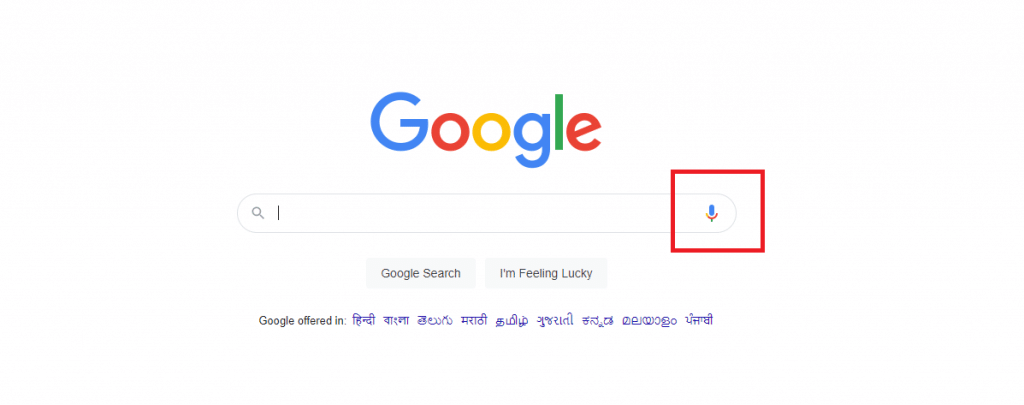The Google search engine is about to become the well-known voice computer in “Star Trek”, so SEO optimizations must go in this direction. Over the past decade, Google has ma de important strides in voice and language processing technology. Google voice search is unique, but it’s more than just a convenience to query a search. Companies and marketers can develop conte nt, advertising campaigns and strategies through voice search.
Learn more about Google Voice!

Google Voice is a feature that allo ws users to search the search engine with voice commands without typing. It is important to know that people can pronounce 150 words, while they can type only 40 words. So speed is essential!
Google Voice is used on both desktop and mobile. Users will press the microphone on the right, say the word or words they want to query, then press OK.
Apart from the way users activate and use voice commands, there are some differences between voice search and regular one. Users who use the mobile device see a different SERP than a desktop user. Usually, the queries obtained are similar, but it is more convenient to speak than to type.
Google Voice is compatible wi th dozens of products and applications. Moreover, voice search has become part of the Google experience and influences how Google’s algorithms handle certa in types of queries.
Semantic search in Hummingbird update
One of the main elements that changed with the adv ent of Hummingbird was the emphasis on semantic search, or the implicit meaning of queries.
Subsequently, the Hummingbird update was so important that Google continued to develop the RankBrain system.
Hummingbird naturally has the role of mak ing improvements to the algorithm and delivering information to web users more accurately. The Hummingbird update does not penalize sites and how they are optimized, it only changes the way Google interprets searches by loading them to reach the meaning behind the keywords entered instead of just summarizing them. It is also a rea ction to the increasing number of conversational searches through mobile phones and voice searches and tries to understand the searcher’s intention to deliver the most appropriate content.
Let’s take a look at semantics using Google Voice Search
For example, we do a voice search for the Prime Minister of India, Mr. Narendra Modi. Once we get to the information, we can ask Google a series of additional questions related to him and his office i.e. PMO.

Google Voice Search, Google Assistant and the future of search
Google Voice Search has been integrated wit h the Google Assistant. The combination of powerful search algorithms with language processing technology makes Google Voice Search more accurate than Apple’s Siri, Microsoft Cortana or Alexa’s Amazon virtual assistants.
Voice search, an upward trend
20% of mobile queries are currently done with voice search.
Mobile Users Are 3 Times More Likely To Use Voice Search
According to review42
Google Voice User Profile
Adults most often use voice search to get directions. If you are behind the wheel, it is easier and safer to use the voice option.
In the image below, we notice that the voice option is also us ed for dictating messages.

According to VoiceLabs, in 2017, approximately 24.5 million mobile devices queried Google Voice. In 2018, 33 million voice search devices are estimated.
How will Google teach you to recognize your voice and habits?
Voice Search and similar techn ologies learn to recognize voice commands and keywords by processing natural language. Over time, Google learns not onl y the unique features of your voice and the way you speak, but also your behavior, browsing interests, and other personal information.
At the same time, Google is constantly learning more about you, about browsing habits, online shopping preferences.
How do we optimize SEO site for voice search?
The good news is that if you use current SEO optimization practices correctly, there are a few things you need to do in addition. The bad news is that if you don’t use SEO techniques, you have a long way to go.
If you have performed a voice search on your mobile device, you have certainly requested specific information about the store address, program, price or information about a certain product. It is essential to structure your site and content so that the user can quickly find this useful information.
Google Voice Search answers questions
Important information such as the store’s address and opening hours must be available on your website. Google is a sophisticated search engine, but it helps you crawl and analyze site content. Images are also important so bring them out in front of you.
MOBILE SEO first of all
It’s no secret that 70 percent of users access VOICE from their mobile phone. Which means focusing SEO on mobile devices.
HOW TO DO IT?
- Use the Google Search Console. Add the mobile version of the site.
- Test if the site is adapted for the mobile version.
- Make sure that your site, the mobile version, does not block CSS, JavaScript, images, videos, etc.
- No FLASH. Flash is not supported by most mobile browsers (and many on the desktop). To ensure that Google (and visitors) can access all content on the site, it is best to avoid using Flash on mobile pages.
- Charging time. 40% of users leave the site immediately if the site is difficult to load
Keyword-based content that answers questions
When you talk on your mobile phone, you treat him like a person and you want to have a dialogue. You guessed it – KEYWORDS must be different from writing SEO for a Google search. We are talking about long-term queries and conversations.
How to do it?
- Create content around questions. Words: WHO ?, WHAT ?, WHERE ?, WHEN ?, HOW ?, WHY? are mainly used. The FAQ method is very helpful.
- Create the Q&A page (questions and answers). It is a method of optimizing your site to respond to point 1 above. Use common expressions with which people resonate in their searches.
Position Zero
The zero position is a piece of the results from the SERP space with a special fragment and offers the best information and the fastest in response to the user’s query.
How do we do it?
Check the site values: It should look good in the eyes of Google, so that it takes over a piece of fragment. Use google analytics to check the pages, take care of the page authority and high quality backlinks.
Reverse pyramid content: Start with the most important information to answer the question, then go through the details and end with examples and a case study.

Optimize the text format: Use paragraphs, tables and lists with titles, chapters and subchapters. Google rewards you for these formats used in a text.
Search engine optimization
The question is whether it’s worth optimizing for search engines other than Google.
If we look at the analyzes made, the answer is YES, it’s worth it! After all, every other search engine is working hard on their platform like Bing has rolled our many updates including in their browser to bring more users to them.
Regarding how you optimize your site for either Google, Bing, Baidu or any other search engine, the rules are largely the same, but with exceptions that can influence.
What else can you optimize for voice search?
Use the metadata schema:
The schema allows you to comprehensively describe what the data on your site means. Google will understand and increase visibility. It is a strong SEO practice that will help you to have the site as visible as possible.
Record and update data on Google My Business
The more current the information, the more rel evant the site becomes, especially for those who ask questions on their mobile phone. So register your company on Google My Business and provide as much data about your business as possible. Leave images, reviews and program, both for customers and for Google.
Ways to offer a better user experience
Optimize
Google Home recommended text snippets when answering a question with information from the site, it will cite the source, the site name and the link to the Google Home application. If you look at articles published on a topic, based on what Google has indexed, you will see that their number has increased 178 times in the last year.
Google Home can drive traffic to sites. It’s a win-win with Google. Google benefits when the snippets provide good answers, and the user is satisfied with the results of Google Home.
In order to provide favorable excerpts, we need to know what queries to provide users with information. Google Search Console is useful in this case.
Context-based query
The difference between mobile and desktop for certain keywords. Mobile SEO differs from desktop because of GPS.
Example: Users access keywo rds for a product or store, and the store program query increases when users are on their way to the location.
Another example is the location, “nearby area”, searches that are dominant on mobile.
Don’t forget about gift shops if it is an event in the near future. There are also searches: until it is open at the mall or florist with non-stop program or restaurant with non-stop program.
Let’s not forget that Google knows how to use synonyms, so there should be no differences between current speech and written expression.
Conclusions
SEO strategies for voice search are strictly rel ated to mobile optimization. Currently, the information provided by Google in this regard is quite scarce, so we must go on the SEO experience gained so far and intuition. SEO optimization for Google Voice means first of all to adapt the text for mobile, because I said that 70% of users come from mobile devices. Google Voice is used behind the wheel, on the road to a location, and users can talk and continue on their way safely.
At the same time, those who talk on the phone will use the current speech, not the literary one, but it is not wrong because the search engine understands synonyms. Don’t forget to use sentences in the form of questions and, if possible, to have a frequently asked questions and answers page.
Did you use Google Voice Search? If so, how did you feel?

